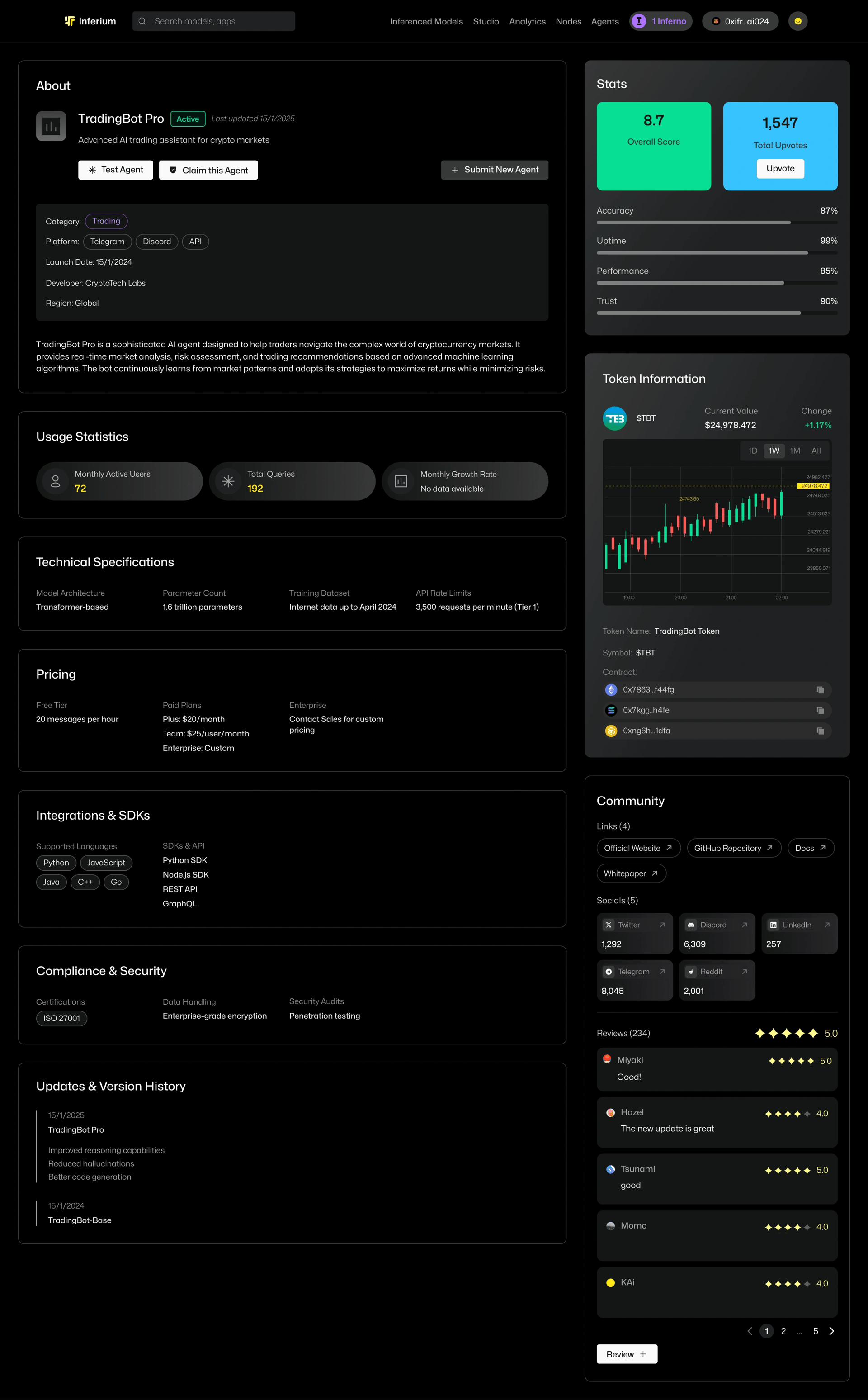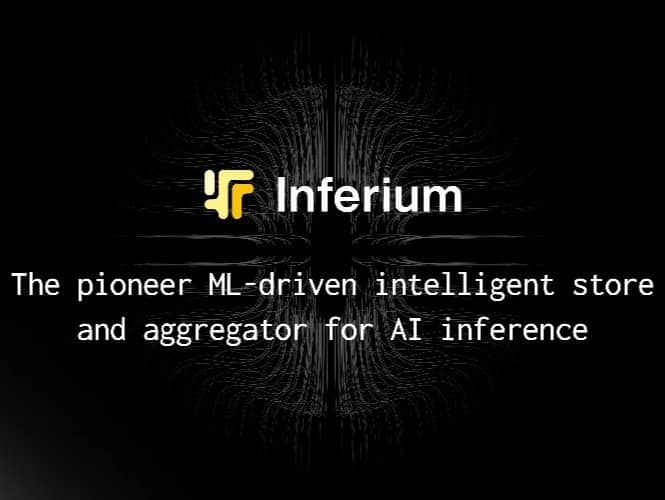위키 구독하기
Share wiki
Bookmark
Inferium AI
Inferium AI
Inferium AI는 검증 가능한 추론 및 AI 에이전트를 위한 AI 인프라 및 분석 플랫폼입니다. 실시간 성능 지표와 추론 증명(Proof of Inference)을 제공합니다. 이 플랫폼은 사용자의 창작, 성능 및 피드백을 포함한 기여에 대해 보상하는 것을 목표로 합니다. [3]
개요
Inferium AI는 검증 가능한 AI 추론 및 agent 배포에 중점을 둔 플랫폼으로, 모델 선택, 투명성, 개인 정보 보호 및 개발자와 최종 사용자 간의 통신과 관련된 주요 과제를 해결합니다. 다양한 AI 모델을 단일 환경으로 통합하여 표준화된 성능 평가와 blockchain 기반의 추론 증명(Proof of Inference)을 제공하여 투명성과 감사 가능성을 보장합니다. 동형 암호화를 통합하여 Inferium은 규제 표준을 충족하는 개인 정보 보호 추론을 지원합니다. 또한 이 플랫폼은 Aethir Cloud 및 io.net과의 파트너십을 통해 확장 가능한 인프라를 지원받는 모델 배포, 테스트 및 검증 도구를 제공합니다. 또한 Inferium은 신뢰할 수 있는 출처의 데이터를 통합하고 사용자 기여 데이터 마켓플레이스를 출시할 계획입니다. 정기적인 업데이트와 사용자 피드백 메커니즘을 통해 개발자는 진화하는 AI 모델을 최신 상태로 유지하여 더욱 정확하고 안전하며 실용적인 AI 솔루션을 배포할 수 있습니다. [1]
특징
모델 저장소
인페리움 모델 저장소는 사용자가 AI 모델을 쉽게 제출, 접근, 평가 및 배포할 수 있도록 하는 플랫폼 기능입니다. 여기에는 팀 친화적인 워크플로우와 모델 업로드 및 통합을 위한 직관적인 인터페이스가 포함됩니다. 저장소의 검색 프로세스는 사용자 행동, 피드백 및 과거 데이터를 분석하여 개인화되고 관련성 있는 모델 권장 사항을 제공하는 머신 러닝 기반 검색 엔진인 매직 검색(Magic Search)을 통해 지원됩니다. 이 시스템은 일일 일괄 추론 및 사용자 상호 작용을 사용하여 결과를 개선하면서 시간이 지남에 따라 적응합니다. 신경망, 의사결정 트리 및 회귀 모델을 포함한 다양한 모델 아키텍처를 사용하며, Random Forests 및 XGBoost와 같은 기술을 사용하여 불균형 데이터 세트를 처리할 수 있습니다.
인페리움에서의 모델 성능은 적응형 메트릭과 사용자 피드백을 통해 평가됩니다. 모델은 분류의 경우 F1 점수 또는 회귀의 경우 평균 제곱 오차와 같이 특정 사용 사례에 맞게 조정된 메트릭을 사용하여 지속적으로 평가됩니다. 사용자는 여러 모델을 테스트, 평가 및 비교하여 집단 추론 점수에 기여할 수 있습니다. 인페리움은 또한 벤치마크하고 모델 품질을 개선하기 위해 경쟁 모델 토너먼트를 개최하며, 과제별 기준에 따라 자격을 갖춘 심사위원이 평가를 수행합니다. 이러한 프로세스는 투명성과 혁신을 촉진하여 플랫폼에서 사용할 수 있는 모델이 정확하고 효율적이며 실제 시나리오에 적용될 수 있도록 합니다. [4] [16]
데이터셋
Inferium은 AI 개발 워크플로우 내에서 데이터셋을 관리하고 활용하기 위한 구조적이고 접근 가능한 환경을 제공합니다. 이 플랫폼은 Rivalz와의 초기 협업을 포함한 파트너십을 통해 고품질 데이터를 소싱하여 강력한 시작 데이터셋 라이브러리를 제공합니다. 앞으로 Inferium은 사용자 제출 데이터셋을 지원하여 커뮤니티 주도의 기여를 장려하고 다양한 도메인에서 데이터셋 다양성을 확장할 계획입니다 across. 데이터셋 라이브러리는 자연어 처리, 컴퓨터 비전 및 오디오 처리를 포함한 다양한 애플리케이션을 다루며, 다양한 머신러닝 작업에 대한 포괄적인 적용 범위를 제공함으로써 Hugging Face와 같은 플랫폼의 구조를 반영합니다.
사용자는 최소한의 설정으로 데이터셋을 검색하고 로드하여 간단한 명령어를 사용하여 프로젝트에 통합할 수 있습니다. 이 플랫폼에는 효율적인 전처리를 위한 도구도 포함되어 있어 사용자가 데이터를 정리하고 변환하여 학습 및 평가를 준비할 수 있습니다. 이 시스템은 메모리 사용량과 성능 병목 현상을 최소화하여 대규모 데이터셋을 효과적으로 처리하도록 설계되었습니다. Inferium은 JSON, CSV, Parquet 및 Apache Arrow를 포함한 common 데이터 형식을 지원하여 다양한 데이터 소스 및 워크플로우와의 호환성을 보장합니다. 이러한 접근 방식을 통해 구조화된 데이터에 대한 간소화된 액세스가 가능해져 더욱 효율적인 모델 개발 및 평가가 가능해집니다. [17]
Inferium Studio
Inferium Studio는 사용자에게 AI 모델을 배포, 테스트 및 공유할 수 있는 유연하고 전용된 공간을 제공하는 기능입니다. 각 사용자는 다양한 머신러닝 작업에 적합한 2개의 CPU, 16GB RAM 및 50GB 저장 용량을 갖춘 기본 환경을 제공받습니다. 사용자는 더욱 고급스러운 작업을 위해 계산 능력과 저장 용량을 늘리도록 Studio를 업그레이드할 수 있습니다. 이 플랫폼은 개인 및 공용 환경에서 모델 호스팅을 지원합니다. 개인 Studio는 안전한 개발을 위한 제어된 접근을 제공하는 반면, 공용 Studio는 커뮤니티 전반의 협업과 지식 공유를 장려합니다. [5] [18]
AI 에이전트 색인
Inferium AI의 AI 에이전트 색인은 AI 에이전트에 대한 실시간 평가 및 검색 시스템입니다. 플랫폼, 사용 사례 및 범주별로 에이전트를 분류하고 정확도, 가동 시간, 대기 시간 및 개발자 투명성과 같은 표준화된 성능 지표를 제공합니다. 각 에이전트에는 이러한 지표를 기반으로 전체 점수(0~5)가 할당되며, 토큰과 연결된 에이전트의 경우 토큰 경제학, 생태계 지원 및 보안과 같은 추가적인 위험 요소도 고려됩니다. Agent IQ는 색인에 대한 공식 분석가 역할을 하며 에이전트 성능에 대한 추가적인 맥락과 통찰력을 제공합니다. 사용자는 사용 추세, 커뮤니티 피드백을 보고 에이전트를 나란히 비교할 수도 있습니다. 토큰으로 제한된 기능은 알파 경고, 과거 데이터 및 프로젝트 예측을 포함한 더 자세한 통찰력을 제공합니다. 이 색인은 확장되는 에이전트 생태계에 구조와 투명성을 제공하도록 설계되어 사용자, 개발자 및 투자자가 성능과 신뢰성을 기반으로 에이전트를 평가할 수 있도록 합니다. [22] [23]

인페리움 노드(Inferium Node)
Architecture
인페리움의 노드 아키텍처는 이중 노드 구조인 워커 노드(Worker Nodes)와 검증자 노드(Validator Nodes)를 통해 분산되고 안정적인 AI 작업 실행을 지원하도록 설계되었습니다. 모델 추론, 벤치마킹 및 검증과 같은 AI 작업 부하는 공유 작업 풀(Task Pool)에 할당되며, 워커 노드는 자체 하드웨어 기능에 맞는 작업을 가져옵니다. 고성능 노드는 모델 호스팅 및 학습과 같은 리소스 집약적인 작업을 처리하고, 중간 수준 노드는 실시간 추론 및 에이전트 작업을 관리하며, 저전력 노드는 리더보드 업데이트와 같은 간단한 작업을 수행합니다.
검증자 노드는 워커 노드 출력을 모니터링하고, 결과를 검증하며, 네트워크를 보호하는 중요한 역할을 합니다. 이들은 검증 가능한 결과가 필요한 AI 계산에 대해 제로지식 증명(zero-knowledge proofs)을 생성하며, 모든 결과는 투명성과 무결성을 보장하기 위해 온체인에 기록됩니다. 이 인프라는 거래가 안전하고 추적 가능한 인페리움의 토큰화된 AI 에이전트 경제를 지원합니다.
시스템 무결성을 유지하기 위해 인페리움은 인센티브 및 패널티 메커니즘을 통합합니다. 워커 노드는 작업 실행 성공에 대해 $IFR 토큰을 얻으며, 인페리움 스튜디오에서 에이전트를 호스팅하여 추가 수익을 얻을 수 있습니다. 검증자 노드는 추론 검증, 거래 보안 및 거버넌스 프로세스 참여에 대해 보상을 받습니다. 작업 완료 실패 또는 잘못된 결과 검증에 대해서는 토큰 공제부터 사기의 경우 네트워크에서 영구적으로 제거하는 등의 패널티가 적용됩니다. [19]
InferNode
InferNode는 Inferium의 Worker Node로, AI 작업을 실행하고, 추론 요청을 처리하며, AI 에이전트를 Inferium Studio 환경 내에서 호스팅합니다. 이러한 노드는 모델을 실행하고, API를 통해 추론을 제공하며, 실시간 AI 상호 작용을 가능하게 하는 컴퓨팅 인프라를 제공합니다. 또한 효율적인 실행을 보장하기 위해 모델 양자화 및 튜닝과 같은 성능 최적화 기법을 지원합니다.
InferNode는 지속적인 에이전트 작업을 유지하고 외부 API 및 애플리케이션과의 상호 작용을 관리함으로써 AI 에이전트 배포를 처리합니다. 토큰화된 AI 에이전트와 관련된 온체인 및 오프체인 활동을 모두 지원하도록 설계되었습니다. 추가적으로, InferNode는 적응형 메트릭을 사용하여 모델 정확도, 대기 시간 및 효율성을 평가하고 Inferium Model Lab에서 성능 순위표를 업데이트하는 벤치마킹 작업을 수행합니다.
이러한 노드는 분산된 GPU 네트워크를 통한 경량 모델 미세 조정 및 대규모 작업 처리를 포함한 분산 AI 계산을 담당합니다. 처리량과 자원 활용률을 향상시키기 위해 병렬 추론 실행을 지원합니다. 데이터 측면에서 InferNode는 데이터셋 준비, 전처리 및 저장을 관리하고, 학습 결과를 개선하기 위해 합성 데이터를 생성합니다. 이러한 기능들의 조합을 통해 InferNode는 Inferium의 분산형 AI 인프라의 운영 중추 역할을 합니다. [6] [11] [14]
VeraNode
VeraNode는 Inferium의 Validator Nodes이며, 네트워크 내 AI 작업 및 구성 요소의 정확성, 보안 및 규정 준수를 검증하는 역할을 합니다. 이러한 nodes는 Zero-Knowledge Proofs (ZKML) 또는 신뢰 실행 환경(TEE)을 사용하여 추론 결과의 유효성을 검증하여 계산이 정확하고 변조 없이 수행되었는지 확인합니다. 검증된 결과는 온체인에 기록되어 실행에 대한 투명하고 감사 가능한 증거를 제공합니다.
추론 검증 외에도 VeraNode는 Inferium Model Lab에 나열되기 전에 AI 모델과 데이터 세트를 평가합니다. 여기에는 백도어나 적대적 행위와 같은 성능, 보안 취약성 및 잠재적 조작에 대한 검사가 포함됩니다. VeraNode는 Inferium Studios에서 호스팅되는 AI agents가 개인 정보 보호 및 윤리적 지침을 준수하는지 확인하고, 사기 활동을 감지하기 위해 시장 거래를 모니터링합니다.
VeraNode는 네트워크 거버넌스의 일환으로 잘못된 결과를 제출하는 Worker Nodes를 식별하고 보고합니다. 잘못된 계산이나 사기 시도에 대한 슬래싱 패널티를 적용하고 호스팅된 모델 및 agents 전반에 걸쳐 AI 라이선스 및 규정 준수를 유지하는 데 도움을 줍니다. 이러한 메커니즘을 통해 VeraNode는 Inferium의 분산형 AI 생태계의 무결성과 신뢰성을 유지하는 데 중요한 역할을 합니다. [6] [15]
Nami Bot
Nami Bot은 Inferium(인페리움)의 AI 어시스턴트로, 사용자가 Telegram 플랫폼을 통해 AI 기능에 원활하게 접근할 수 있도록 설계되었습니다. 다용도 인터페이스를 통해 사용자를 Inferium 생태계에 연결하여 AI 에이전트 및 Inferium과 Hugging Face(허깅 페이스)와 같은 플랫폼의 모델을 검색할 수 있습니다. Nami Bot을 사용하면 성능, 사용 사례 및 평가 지표별로 모델을 필터링하여 특정 요구 사항에 가장 적합한 모델을 찾을 수 있습니다.
모델 검색 외에도 Nami Bot을 통해 Telegram에서 AI 모델과 직접 상호 작용하고, 텍스트 생성, 이미지 분류 및 텍스트-3D 렌더링과 같은 추론 요청을 지원합니다. 사용자는 성능 지표와 온체인 또는 오프체인 데이터 평가를 사용하여 모델을 평가할 수 있습니다. 이 봇에는 $IFR 토큰을 안전하게 관리하고 플랫폼 서비스에 대한 결제를 용이하게 하는 내장 지갑이 포함되어 있습니다. 개발자는 Telegram 내에서 여러 프로그래밍 언어로 코드 스니펫을 디버깅할 수 있으며, 사용자는 메타데이터와 벤치마크를 포함하여 새로운 모델을 온보딩할 수 있습니다. 또한, Nami Bot은 모델을 선택하고 개인화된 스튜디오에 배포하여 사용자 지정 AI 애플리케이션 또는 에이전트를 생성하여 대화형 인터페이스를 통해 AI 앱 개발 및 배포를 간소화합니다. [12]
IFR
$IFR 토큰(token)은 인페리움(Inferium) 생태계의 기본 구성 요소이며, 거버넌스, 스테이킹, 거래 수수료, 그리고 인센티브 제공 등 여러 목적으로 사용됩니다. 토큰 보유자는 투표권을 가지며, 기능 개발 및 생태계 확장과 같은 플랫폼 결정에 영향을 미칩니다. 또한, 토큰은 스테이킹 메커니즘으로 기능합니다. 사용자는 모델 자격을 얻기 위해 밸리데이터가 되려면 $IFR 토큰을 스테이킹해야 하며, 스테이킹 보상은 지속적인 네트워크 참여를 장려하도록 설계되었습니다.
또한, $IFR 토큰은 사용자가 모델 사용에 할당된 공간을 초과하거나 맞춤형 모델 구성, 전용 추론 API 및 우선 지원과 같은 프리미엄 서비스에 액세스할 때 거래 수수료를 지불하는 데 사용됩니다. 이 토큰은 개발자와 사용자에게 인센티브를 제공하는 보상 시스템의 기반이기도 합니다. 개발자는 성능이 우수한 모델에 대해 $IFR 보상을 받고, 사용자는 모델 테스트, 피드백 제공 및 커뮤니티 이니셔티브 참여와 같은 활동에 대해 토큰을 얻습니다. 이러한 구조는 플랫폼 전반에 걸쳐 장기적인 성장과 적극적인 참여를 지원합니다. [20]
토큰 경제학
IFR은 총 2억 5천만 개의 토큰을 공급하며, 다음과 같이 배분됩니다: [20]
- 커뮤니티 보상: 26%
- 생태계 성장: 24%
- 토큰 판매: 21.6%
- 유동성: 14%
- 팀 및 자문위원: 8%
- 재무부: 6.4%
인페르노
인페르노 포인트는 사용자 참여와 지속적인 활동을 장려하기 위해 고안된 인페리움 플랫폼 내의 게임화된 보상 시스템입니다. 사용자는 다양한 플랫폼 관련 활동을 수행하여 포인트를 얻을 수 있으며, 이후 $IFR 토큰으로 교환할 수 있습니다. 포인트를 생성하는 활동에는 매일 로그인, AI 모델 배포, 추론 작업 완료 및 모델 평가가 포함됩니다. 토론에 참여하고, 공동 프로젝트에 참여하고, 경쟁 또는 토너먼트에 참여하는 것을 포함한 커뮤니티 참여를 통해 추가적인 포인트 획득 기회가 생깁니다. 사용자는 다른 사람을 플랫폼에 추천하고 게시물에 좋아요를 누르거나 댓글을 다는 등의 소셜 상호 작용을 통해 보상을 받습니다.
누적된 인페르노 포인트는 사용자 대시보드의 전용 교환 프로세스를 통해 $IFR 토큰으로 교환할 수 있습니다. 플랫폼은 참여와 토큰 분배 간의 안정적인 균형을 유지하기 위해 주기적으로 고정 환율을 설정합니다. 일단 교환되면 $IFR 토큰은 인페리움 내의 서비스에 사용하거나 외부에서 거래할 수 있습니다. 인페르노 포인트 시스템은 사용자 유지를 강화하고, 의미 있는 기여를 유도하며, 활동적이고 커뮤니티 중심적인 참여를 통해 플랫폼의 성장을 지원합니다. [21]
파트너십
- Laika AI (라이카 AI)
- Renatus (레나투스)
- Amplifi (앰플리파이)
- Datalayer (데이터레이어)
- Fetch.ai (페치.에이아이)
- ElizaOS (엘리자OS)
- AgentLayer (에이전트레이어)
- Fusion AI (퓨전 AI)
- Gaimin (가이민)
- Cluster Protocol (클러스터 프로토콜)
- PrivateAI (프라이빗AI)
- Tada (타다)
- Tenzro (텐즈로)
- Marlin (말린)
- Rivalz (라이벌즈)
- Oasis (오아시스)
- Exabits (엑사비츠)
- Mind Network (마인드 네트워크)
- Segmind (세그마인드)
- Din (딘)
- Glacier (글래시어)
- Aethir (에시르)
- IO.net (IO.넷)
- Hybrid (하이브리드)
잘못된 내용이 있나요?
